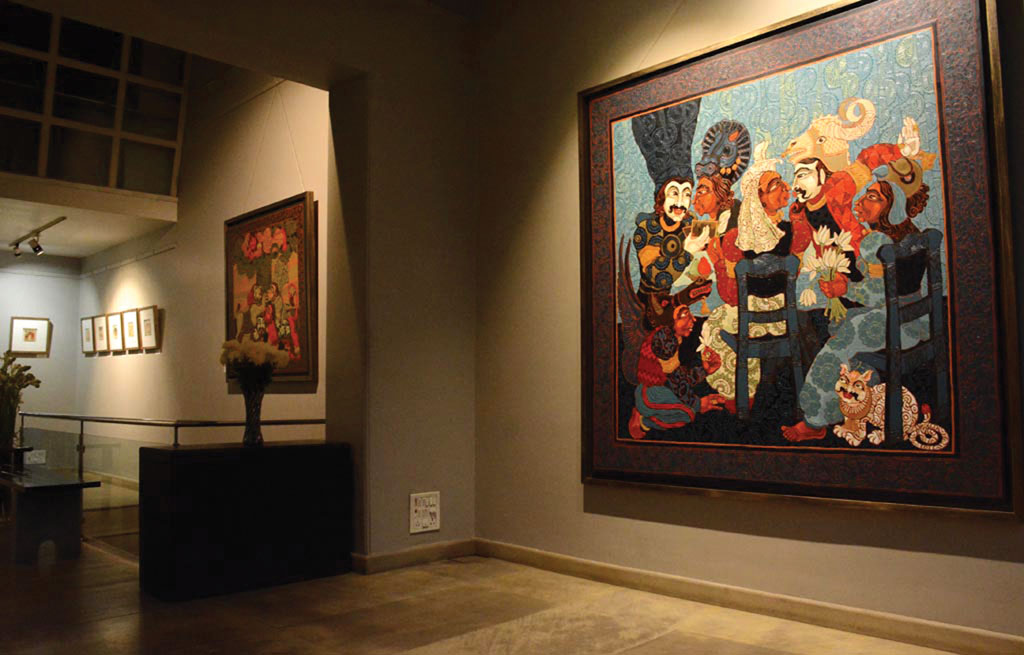Mohit Jain

The Dhoomimal name is now touching eighty -three years of promoting contemporary Indian art, in this capacity a flagship enterprise within the fraternity, having witnessed the evolution and growth of art and institutions from their very inception within the country.
Established in pre-independence India by Ram Babu, the Dhoomimal was supported by stalwarts of the time, like B. C. Sanyal, Jaya Appaswamy, Jamini Roy, Sailoz Mukherjee and Nand Lal Bose and host of other, to be followed by generations after them.
Son Mohinder Jain with wife Sushma carried forward the same passion, standing steadfast in their dedication and support as major players in the capital’s art world. Young artists of the sixties and seventies, recognised as Masters of today, had all been given their first solo shows at Dhoomimal. This is true of painters, sculptors and graphic artists, all of who were given equal sway in what was probably the most alive art hub of the country at the time.
As the third generation, Mohit Jain, Director DAC, recalls how the art scenario of time was a passion engendering investment at altogether different levels, instead of being beleaguered by solely economic concerns.
Q. 1. When did you understand the nature of your father’s profession?
Mohit Jain : I was 5 or 6 years old when I started visiting the gallery and found the environment amazing but as I grew older, I saw the artists getting loud in a group, arguing, smoking, drinking and that put me off. I never wanted to run my father’s business. Destiny had something else in the store for me. My father’s demise, when I was only 16 made me rethink and I started joining my mother at work and got into this Art world.
Q. 2. How do you see Dhoomimal different from the Art Galleries of that period?
M. J. : Well, in Delhi there were not many galleries at that time and one of them was owned by a close relative only. In those days Art and artists mattered a lot and were the prime concern. The commercial side of it did not surface much, it came later.
Q. 3. Name the trait that has helped you in running the family business.
M. J. : My father had another business as well and through Art Gallery his main focus was on the upliftment of the artists. He always gave moral and financial support to many without making them feel needy. He was a kind of patron and encouraged them to continue their pursuit to attain certain goals.
My exposure to art and artists has sensitized to me on similar lines. I had the rare opportunities to meet great artists like G. R. Santosh, S. R. Bhushan, B. Prabha, B. Vitthal, Swaminathan, M. F. Husain, Shanti Dane, Bikas Bhatacharya and many more.
Q. 4. Selling art is very different from selling any other commodity. Do you try to understand the psyche of an artist while buying and selling his art ?
M. J. : I am the third generation in this line and from my grandfather’s time, we have been compelled by the environment to understand the need of promoting younger artists who look for an opening. I make myself approachable and try to help the lesser known and upcoming artists to give them an appropriate platform.
Q. 5. Do you remember any artist who has left an impression on your personality and made you a better collector or art dealer ?
M. J. : Yes, G. R. Santosh. He was a very different kind of an artist, extremely humble, down to-earth and used to guide me in a very subtle manner.
Q. 6 In the changing times, art has evolved a lot. How do you relate to the Contemporary Art ?
M. J. : Well, it is taken long time for me to appreciate it, I believed in the principles of art in its creation and I found old master’s works skill based. Lot of efforts were taken in establishing those individual styles, whereas now its all sacrificed. Some of the new works are also amazing but my favourite ones are still old works.
Q. 7. Several Art Galleries are mushrooming, what is your reaction to this fast growth ?
M. J. : It has both positive and negative impact, the positive side is that it is giving chance to many new artists and spreading awareness of art appreciation. The negative side is that due to the commercial angle it is misleading in the name of art. It has to be done very professionally with a deep passion for art and also understand it well. It has to be based on learning about Art.
Q. 8. What should be the code of ethics in your trade ? Give a message to new gallery owners.
M. J. : Be selective, do not rush to exhibit for the sake of running in a rat race and more importantly, never ridicule the work of any artist on display in another gallery. Always put passion before the commercial benefits.
Q. 9. You have a rich collection from your grandfather, father and your own purchases. Mention your favourite piece in the collection.
M. J. : It’s a small work by Ram Kinker, an animal figure (monkey/dog). I have displayed it in my room at home.
Q. 10. With so many art events, festivals and camps, how do you see the future of art in India ? Where do we stand at the international level ?
M. J. : We have arrived at the international level. Last year (2019), we had our Indian Pavilion at Venice Biennale. The works of artists impressed the crowd. The best was that the works were dominated by the Indian ethos. We have made a massive impact and that is both satisfying and encouraging.







